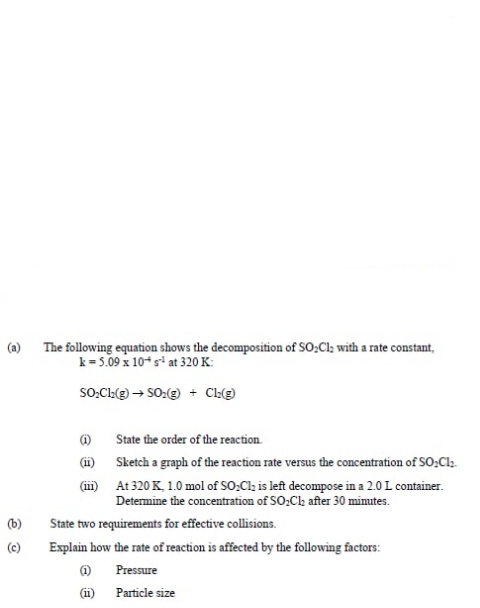(n) The following equation shows the decomposition of SO;Cl; with a rate constant, k- 5.09 x 10* s at 320 K: SO.Ch(2) + SO:(g) + Cl(g) O State the order of the reaction. (i) Sketch a graph of the reaction rate versus the concentration of SO;Cl. (iii) At 320 K, 1.0 mol of SO;Cl, is left decompose in a 2.0 L container. (1) Determine the concentration of SO:Cl, after 30 minutes. (b) State two requirements for effective collisions. (c) Explain how the rate of reaction is affected by the following factors: Pressure (ii) Particle size (11)
(n) The following equation shows the decomposition of SO;Cl; with a rate constant, k- 5.09 x 10* s at 320 K: SO.Ch(2) + SO:(g) + Cl(g) O State the order of the reaction. (i) Sketch a graph of the reaction rate versus the concentration of SO;Cl. (iii) At 320 K, 1.0 mol of SO;Cl, is left decompose in a 2.0 L container. (1) Determine the concentration of SO:Cl, after 30 minutes. (b) State two requirements for effective collisions. (c) Explain how the rate of reaction is affected by the following factors: Pressure (ii) Particle size (11)
Chemistry by OpenStax (2015-05-04)
1st Edition
ISBN:9781938168390
Author:Klaus Theopold, Richard H Langley, Paul Flowers, William R. Robinson, Mark Blaser
Publisher:Klaus Theopold, Richard H Langley, Paul Flowers, William R. Robinson, Mark Blaser
Chapter12: Kinetics
Section: Chapter Questions
Problem 43E: Some bacteria are resistant to the antibiotic penicillin because they produce penicillinase, an...
Related questions
Question

Transcribed Image Text:(a) The following equation shows the decomposition of SO;Cl; with a rate constant,
k= 5.09 x 10*s' at 320 K:
SO:Che) → SO:(e) + Che
State the order of the reaction.
(ii)
Sketch a graph of the reaction rate versus the concentration of SO:Cl.
(iii) At 320 K, 1.0 mol of SO:Cl, is left decompose in a 2.0L container.
Determine the concentration of SO:Clh after 30 minutes.
(b)
State two requirements for effective collisions.
(c)
Explain how the rate of reaction is affected by the following factors:
(1)
Pressure
(1)
Particle size
Expert Solution
This question has been solved!
Explore an expertly crafted, step-by-step solution for a thorough understanding of key concepts.
Step by step
Solved in 2 steps with 2 images

Knowledge Booster
Learn more about
Need a deep-dive on the concept behind this application? Look no further. Learn more about this topic, chemistry and related others by exploring similar questions and additional content below.Recommended textbooks for you

Chemistry by OpenStax (2015-05-04)
Chemistry
ISBN:
9781938168390
Author:
Klaus Theopold, Richard H Langley, Paul Flowers, William R. Robinson, Mark Blaser
Publisher:
OpenStax

Chemistry for Engineering Students
Chemistry
ISBN:
9781337398909
Author:
Lawrence S. Brown, Tom Holme
Publisher:
Cengage Learning

Chemistry: Principles and Reactions
Chemistry
ISBN:
9781305079373
Author:
William L. Masterton, Cecile N. Hurley
Publisher:
Cengage Learning

Chemistry by OpenStax (2015-05-04)
Chemistry
ISBN:
9781938168390
Author:
Klaus Theopold, Richard H Langley, Paul Flowers, William R. Robinson, Mark Blaser
Publisher:
OpenStax

Chemistry for Engineering Students
Chemistry
ISBN:
9781337398909
Author:
Lawrence S. Brown, Tom Holme
Publisher:
Cengage Learning

Chemistry: Principles and Reactions
Chemistry
ISBN:
9781305079373
Author:
William L. Masterton, Cecile N. Hurley
Publisher:
Cengage Learning

Chemistry & Chemical Reactivity
Chemistry
ISBN:
9781133949640
Author:
John C. Kotz, Paul M. Treichel, John Townsend, David Treichel
Publisher:
Cengage Learning

Chemistry & Chemical Reactivity
Chemistry
ISBN:
9781337399074
Author:
John C. Kotz, Paul M. Treichel, John Townsend, David Treichel
Publisher:
Cengage Learning

Chemistry: Principles and Practice
Chemistry
ISBN:
9780534420123
Author:
Daniel L. Reger, Scott R. Goode, David W. Ball, Edward Mercer
Publisher:
Cengage Learning